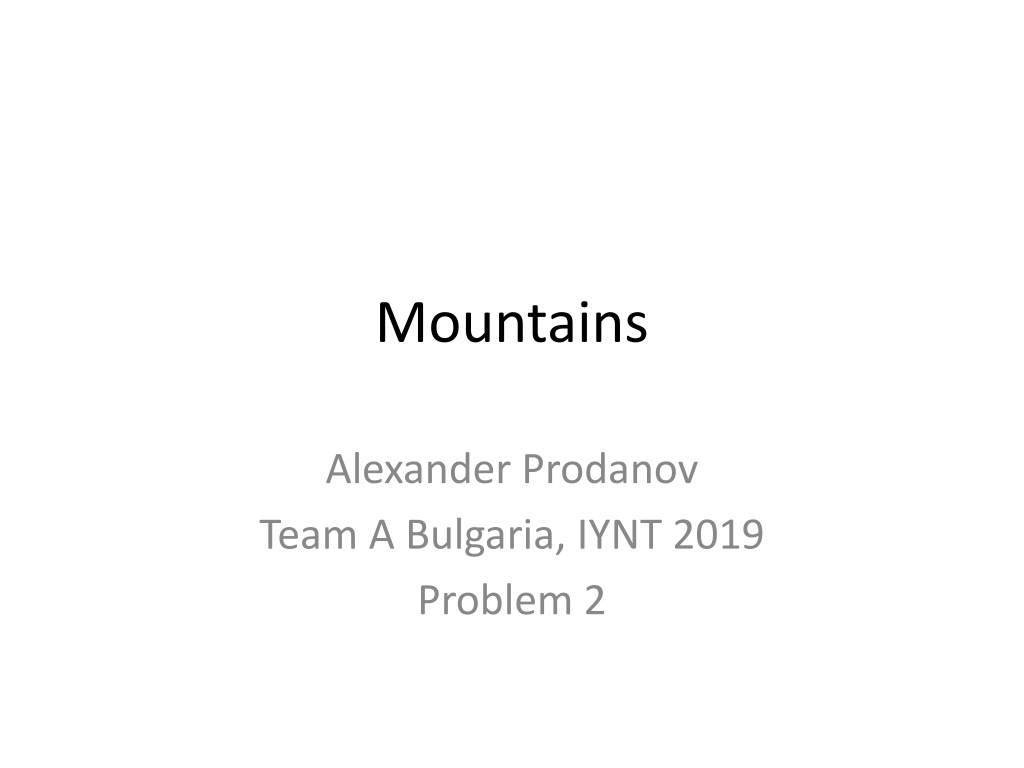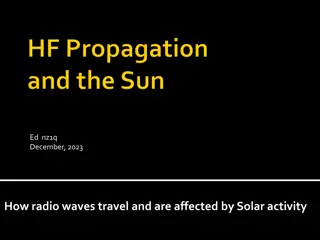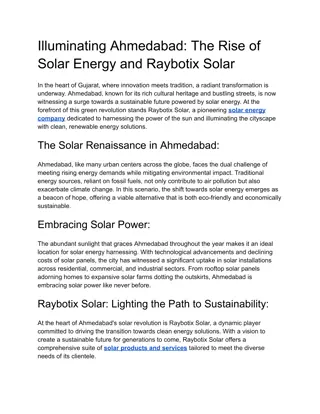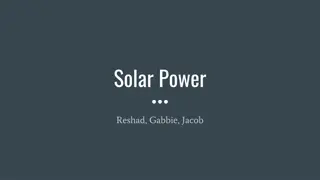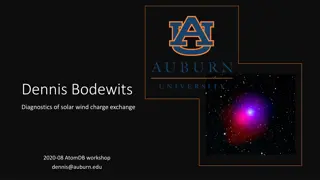Analyzing Tallest Mountains in the Solar System
This document explores the tallest mountains in the Solar System and proposes theoretical models for predicting their maximum altitudes on various celestial bodies. It discusses the heights of mountains on Mercury, Earth, Moon, Mars, Vesta, Ceres, Io, and other celestial bodies, along with different formation mechanisms such as tectonic, volcanic, cryovolcanic, and impact-related. Theoretical models for tectonic, volcanic, and impact mountains are analyzed, providing insights into their composition and structure.
Download Presentation

Please find below an Image/Link to download the presentation.
The content on the website is provided AS IS for your information and personal use only. It may not be sold, licensed, or shared on other websites without obtaining consent from the author.If you encounter any issues during the download, it is possible that the publisher has removed the file from their server.
You are allowed to download the files provided on this website for personal or commercial use, subject to the condition that they are used lawfully. All files are the property of their respective owners.
The content on the website is provided AS IS for your information and personal use only. It may not be sold, licensed, or shared on other websites without obtaining consent from the author.
E N D
Presentation Transcript
Mountains Alexander Prodanov Team A Bulgaria, IYNT 2019 Problem 2
The problem What are the tallest mountains in the Solar System? Propose and analyze the theoretical models that can allow predicting the maximum altitudes of mountains on various celestial bodies.
Body Highest peak Base-to-peak height Mercury Caloris Montes 3 km Earth Mauna Kea and Mauna Loa 10.2 km Moon Mons Huygens 5.5 km Mars Olympus Mons 21.9 km Vesta Rheasilviacentral peak 22 km Ceres Ahuna Mons 4 km Io Bo saule Montes"South" 17.5 to 18.2 km Mimas Herschelcentral peak 7 km Dione Janiculum Dorsa 1.5 km Titan Mithrim Montes 3.3 km Iapetus equatorial ridge 20 km Oberon unnamed ("limb mountain") 11 km Pluto Tenzing Montes, peak "T2" ~6.2 km Charon Butler Mons 4.5 km These altitudes are all topological prominence(Base-to-peak)!
Different formation mechanisms There are 3 basic(common) types of mountains: Tectonic formed due to tectonic plate movement Volcanic or Cryovolcanic formed due to volcanic activity Impact formed from the debris after an impact crater is created
Tectonic They form when two tectonic plates collide and overlap. Most of the time, they have homogenous composition. Most of the time, they are in the form of mountain ranges, so they can be modeled as a solid with the same cross section everywhere. While their height is typically around 8km(base-to-peak height), the tectonic plates are 100-200km thick.
Volcanic and Cryovolcanic They form when a volcano(cryovolcano) spits out the lava(cryolava), which hardens on the sides forming a slope of specific steepness determined by the cohesion of the material. Volcanic mountains are comprised of alternating layers of volcano dust and hardened lava(basalt) They can be very well approximately modeled as a truncated cone, or even as a cone.
Impact They are created when a space rock hits the surface of a planet(preferably without atmosphere). The debris from the crater concentrate around the rim and create a hill , which is called an impact mountain. It mainly consists of basalt rock from the surface. We can approximate them the same way we approximated tectonic mountains.
Model 1: Melting of the mountain bedrock All of the different types of mountains we described earlier, have some type of basalt bedrock and thus are suitable for this model. If the mountain is too heavy and creates enough pressure on the bedrock, then it would melt. That way the mountain will sink a little bit and thus it won t be as high as before. We need to find what is the height at which this happens.
Model 1: Finding Hmax Tectonic and Impact ? ?= ?(?,?) = ?? ?,? ? ? ? =1 =??? ??? ? ? ? ?=? 2?? ? ? ????=2??? 2 ???
Model 1: Finding Hmax Volcanic and Cryovolcanic ? ?= ?(?,?) = ?? ?,? ? ? ? =1 =??? ??? ? ? ? ?=? 3?? ? ? ????=3??? 3 ???
Model 1:Results Earth and Mars Type Theoretical Reality Tectonic and Impact 97.8km 5.3km to 5.9km Volcanic and Cryovolcanic 122.3km 10.2km Type Theoretical Reality Tectonic and Impact - - Volcanic and Cryovolcanic 323.4km 21.9km
Model 2: Yielding criterion Every material, including the rock from which the mountain is made, can withstand a certain amount of mechanical stress before yielding. This puts a upper boundary on the maximal height of a mountain. When the shear stress on some plane gets larger than a given value Y(yield strength), the rock yields.
Model 2: Yielding criterion Let s first apply dimensional analysis. ? = ??.? 3 ? = ?.? 2 ? = ?? = ??.? 1.? 2 = ? Suppose ~?????? Then ?1?0??0= ? 3?+? ?? 2(?+?)???+?
Model 2: Yielding criterion So 3? + ? ? = 1 2 ? + ? = 0 ? + ? = 0 We get =-1 , =-1, =1 r: ? ????= ? ?? Where is a numerical factor, which depends on the form of the mountain.
Model 2: Yielding criterion ?(?) ?(?) ? ? ? ?(?) ? ?(?)
Model 2: Yielding criterion Tectonic and Impact ? ? =1 ?2+ 2sin ? ? ? 2? h ? =????? ? ? =1 2 ? 1 2 ? ?2+ 2?sin ? sin ? ? ?2+ 2?sin2? b 2 4? ?? 4? ??+ ? ????
Model 2: Yielding criterion Moment balance By equating the moments applied to this circular area to the maximum possible moment created by the shear force we get yet another height limit. 3?? ?? ????
Model 2: Yielding criterion Tectonic and Impact From the said before we get: 3?? ??, 4? ?? 4? ??+ ? ???? min For typical granite and the b 500km(for the Himalayas) we get that they can t be higher than 57km.
Model 2: Yielding criterion Tectonic and Impact Because of the way tectonic mountains form, they can t be higher than the height of a single mountain with comparable base and height. If we approximate h=2b, then 2 ? + ? 2 4 + ? ????= ?? ?? ??
Model 2: Yielding criterion Volcanic and Cryovolcanic Cone cross section ? ? =1 ?2+ 2sin ? ? ? 3? h ? =????? ? ? =1 3 ? 1 3 ? ?2+ 2?sin ? sin ? ? ?2+ 2?sin2? R 2 6? ?? 6? ??+ ? ????=
Model 3: Maximum Volcano height H ?? D ?? ?0+ ???? = ?0+ ?mg D + Hm ?? ?? ?? ? ??
Volcanic mountains From the said above we can deduce that 6? ?? 6? ??+ ? ,?? ?? ???? min ? ?? But if we know the angle of repose of the volcano, then: 3 cot ? + 4+cot2? ? ,?? ?? ?? ???? min ? ??
Test for Model 2: Yielding criterion Spherical asteroids (? ?) Small flatness ? = It can be shown that: ?. a b 3 1 ? ? ? 2?? ? For flatness ? 10%, e 0.4, 2500??/?3, Y 10???, gives us a radius of around 270km. Real measurements give us radius of about 300km.(These are results for rocky asteroids)
Numerical results and comparison Earth and Asteroids Model Theory Reality Tectonic(model 1) 97.8km 5.6km Tectonic(model 2) 31.0km 5.6km Volcanic(model 1) 122.1km 10.2km Volcanic(model 2,3) 30km 10.2km Asteroid(test of model 2) 270km 300km
Conclusion and final remarks We analysed different theoretical models for predicting the maximum height of a mountain on a given celestial body. Most of these methods are overestimating the real value, because of other factors such as erosion, already present mechanical stresses, inhomogeneity of the mountain, mechanical instabilities and etc. Most of the values used in the calculations, are not accurate. Those values are almost impossible to measure directly and calculate indirectly. That s why we get only the results only in the order of magnitude.
Sources P. A. G. Scheuer, How high can a mountain be? MinutePhysics, How tall can a mountain be? Wikipedia Strength criterion for rocks under compressive-tensile stresses Charles H. Lineweaver, Marc Norman Potato radius
